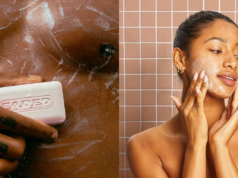Okay, I’ma be honest: Figuring out the correct order of your skincare routine can be massively confusing. Actually, no, skincare itself is just massively confusing. Ask a dozen people what to put on your face, and you’ll get a dozen wildly different answers—most of which are straight-up wrong (sry to your ex–high school friend turned Facebook skincare consultant). Like, do I actually need 10 products (no)? Also, what comes first, serum or toner? Or, wait, face oil? Is that before or after moisturizer? OH, and RETINOL. DO I NEED RETINOL?!
Listen, I get it. It’s not like we’re born with an innate knowledge of what order to apply skincare products, and that sucks. Because what you use (and how you use it) genuinely matters, and layering them incorrectly—or picking the wrong formulas for your skin type—could render them totally ineffective or just hardcore irritate your face. Not ideal.
But don’t freak—I spend my life reciting the skincare product steps like the commandments, and now I shall impart my ~holy~ wisdom onto you. Below, I broke down the correct order to apply your skincare, the steps you can definitely skip, and the best products for your exact skin type. …We better be best friends after all this, because wow.
Let’s begin.
You DO NOT NEED an eight-step skincare routine. Most faces do far better with fewer products, so if you’re just starting out, keep it simple: Cleanser, moisturizer, sunscreen. That’s it. Three products. Seriously. Got dry skin? Maybe throw in a face oil or hydrating serum. Dealing with breakouts? Add on a retinoid or an acne toner. Go slow, keep it simple, and you’ll be golden. Now for the goodies…
Please, for the love of the beauty gods, remove your makeup and wash your face before slathering on your products. “For ingredients to properly absorb, you need clean skin that’s totally free of oil and grime,” says dermatologist Mona Gohara, MD, associate clinical professor at Yale School of Medicine.
Which means if you want to do things right—and, like, why you here if not tho?—skip the makeup wipes (they leave behind a layer of gunky residue that can break you out) and opt for a cleansing oil, which dissolves all makeup without stripping your skin. Then follow up with a gentle, creamy cleanser (especially if you have acne-prone skin). And don’t complain about this being a two-step process—it’s one of the only required steps in this entire routine. I’m not even a little sorry. NOPE.
Back in the day, toners were these alcohol-based liquids that irritated the hell out of your face and left you stinging. But today’s toners are filled with either gentle, hydrating ingredients to coddle dry skin or chemical exfoliants to treat acne. “They’re not meant to be something that sits around on your skin and feels heavy,” says Dr. Gohara. “They’re essentially just priming your face for ingredients to be better absorbed later on.” Reminder: Toners (like most of the steps on this list) are totally optional.
Since there are a million different toners on the market, here’s how to find the best one for your skin type:
Look for a toner filled with either BHA (beta hydroxy acid, like salicylic acid) or AHA (alpha hydroxy acid, like glycolic acid or lactic acid), which work to unclog pores, prevent breakouts, and dissolve blackheads over time. If you’ve got dry skin, try AHAs, and if you’ve got oily skin, stick with BHAs.
After cleansing, tap them over clean, dry skin every other night (or every other morning, if you plan to use a retinol at night), then wait a full five minutes—or, at the very least, until they dry—before applying anything else or you’ll accidentally neutralize the acids before they work their magic.
You can opt for a hydrating toner, which helps replenish any water your skin barrier lost when you washed and dried your face. After cleansing, tap one over your clean, dry skin every morning, every night, or both: “There’s no such thing as too much moisture, regardless of your skin type,” says Dr. Gohara. Basically, moisture makes your face happy. Make your face happy, k?
Ah, serums—you’ve seen them, you’ve probably got some sitting in your cabinet, and you’re not totally sure what to do with them. You’re not alone. “Serums are essentially just shots of extremely concentrated nutrients, hydrators, and antioxidants that really amp up your skin health as soon as you apply them,” says Dr. Gohara. “People often skip out on using them, but they’re honestly the heavy lifters of your skincare routine.” Basically, think of toners like a sip of beer, and serums like a straight shot of tequila.
Though, once again, serums are totally optional, they’re often a good first step in leveling up your skincare routine.
Dr. Gohara (and every other derm in existence) swears by vitamin C serum, which protects your skin from the inflammation and damage caused by free radicals during the day while also brightening skin and lightening dark spots over time. It’s really the MVP of skincare ingredients, buuut it’s also a little strong. So if your skin is sensitive, use it every other morning instead of every day.
Opt for a serum filled with hyaluronic acid, which pulls water from the air into your skin to plump it up and keep it hydrated while you sleep. “If you’re using acne treatments or anti-aging products, which can be drying and irritating, you want to prep your skin with as much moisture as possible first,” says Shereene Idriss, MD, a cosmetic dermatologist in NYC.
Eye creams tend to be lighter and thinner than face moisturizers, so make sure to apply them before you slather on your creams and oils. “The rule of thumb when applying skincare is to apply the lightest first and the heaviest last, since thinner products can’t penetrate thicker products,” says Dr. Idriss. Yeah, it’s annoying how much this all makes sense now, isn’t it?
Still, even though eye creams seem like the end-all-be-all of skincare (and anti-aging), they’re honestly not necessary for most people. “As long as you’re using moisturizer and sunscreen, your eye area is already getting the TLC it needs,” says Dr. Gohara. But if you wanna try one out, here’s how to choose:
Look for an eye cream that has a rollerball applicator (“the cold steel ball helps a bit with fluid retention—aka under-eye bags—especially if you keep the cream in the fridge between uses,” says Dr. Gohara) and a formula filled with caffeine, which helps temporarily constrict and tighten puffy under-eyes within 20 minutes.
“Most people think their night eye cream has to contain some sort of retinol to help with fine lines, but in reality, your eye area is delicate and at risk for rashes and irritation, so you want to be gentle,” says Dr. Gohara. “Instead, tap on a simple, hydrating eye cream that’ll protect your under-eyes and repair your skin barrier overnight.”
Yes, you can—and should!—use a retinol around your eyes, but “it’s better to apply retinoids to your whole face rather than to just spot-treat parts of it,” she says. (Don’t worry, retinol options will come later on.)
Ideally, you’d apply your spot treatments (whether they’re for zits, scars, or dark spots) at night because that’s when your body’s working hardest to repair itself. But if you’ve already used an acne-fighting toner and/or you’re planning to layer on a retinol, try spot-treating in the morning instead so you don’t irritate your skin all at once.
Regardless of when you apply it, make sure to tap your spot treatment on before your moisturizer so it can really penetrate your skin and do its thang without having another barrier to penetrate.
Dr. Idriss recommends using a spot treatment with either hydroquinone (a skin-bleaching ingredient that works fast but can be irritating on anyone with even slightly sensitive skin) or niacinamide (aka vitamin B3), which gently brightens marks and scars over time. Niacinamide can be used daily—most formulas won’t cause irritation—but hydroquinone should be used every other day (or every three days) until you know how your skin responds to it.
Dr. Gohara stands by tried-and-true benzoyl peroxide and salicylic acid—but not together, unless you want to irritate your skin. Benzoyl peroxide kills acne-causing bacteria (use it for classic whiteheads), while salicylic acid dissolves oil and skin cells (use it for little clogged pores and inflamed bumps).
Regardless of which you choose, the application is the same: Dab a thin layer (seriously—more isn’t merrier here) over your spot or zit, then wait at least a full minute for it to dry. Then, to prevent the treatment from getting wiped around your face, apply your moisturizer around the spots first. When your face is covered, tap a layer of moisturizer directly over the spot treatment to seal it in without sliding it around.
You need to be using a moisturizer. Always. Twice a day. No matter what. I don’t care if your skin is hella oily or easily broken out or sad or scared (there’s a formula for you! Promise!) because it’s the only thing that’ll keep your skin barrier—aka the very temperamental thing responsible for making your face look good—healthy. Plus, “a moisturizer not only infuses your skin with hydration but also helps trap in all the products underneath it to make the ingredients even more effective,” says Dr. Idriss.
Look for a light, gentle, hyaluronic-based moisturizer, which will keep skin hydrated without feeling heavy or greasy. And ideally, get a formula with a sunscreen of at least SPF 30 in it, especially if you’re not planning to slather on a separate sunscreen later. Whichever you choose, let it sink in for at least a full five minutes before applying makeup (if, you know, this is the end of your skincare routine, and makeup is your next step).
“Your skin goes into repair mode at night, working extra hard to fix damage and boost regeneration,” says Dr. Gohara. “So your night moisturizer should be filled with all of the things your body naturally produces and can use more of, like hyaluronic acid, lipids, and proteins.” You can also tiptoe into the retinol game by using an anti-aging night cream, which has a “watered-down” dose of retinoids that tend to be gentler, especially on sensitive skin.
“Retinoids—the general term for all vitamin A derivatives, including retinol—sink into your skin to speed up cell turnover, causing your body to churn out fresher, smoother, less wrinkled skin over time,” says Dr. Gohara. Good things take time, though, so remember that retinoids take four to six months of consistent use to give you results.
But just because it might take half a year to see your wrinkles smooth out doesn’t mean you won’t see more immediate results in other ways. “Retinoids trigger collagen production and cellular exfoliation, which means they’ll also fade dark spots, smooth scars, clear pores, prevent breakouts, and brighten skin,” she says. Basically, retinoids are the closest thing to magic that dermatologists have.
If you’re new to retinoids, make sure to start slow to mitigate the initial adjustment period of flakes and sensitivity. “Apply a pea-size drop to your entire face one night a week for one week, then two nights a week for two weeks, then three nights a week for three weeks, and then every other night indefinitely,” says Dr. Gohara.
You’re already using (or planning to use) a night cream with retinoids, since doubling up won’t make the anti-aging results more effective—it’ll just cause inflammation. And if you do have extra-sensitive skin, apply a layer of moisturizer both 10 minutes before and after applying your retinol to reduce irritation without totally diluting the treatment. Basically, sandwiching your face in moisture.
“Face oils are occlusive, meaning they seal in all the ingredients and moisture you just applied to your face to keep them from evaporating as quickly,” says Dr. Idriss. On their own, oils don’t actually moisturize your skin that well, but when you layer them over products, they help increase your routine’s efficacy while also leaving skin soft and smooth. Just make sure to always, always, apply your oils last. Yes, you read that correctly.
“Oils can easily penetrate moisturizers, serums, and treatments, but no products can penetrate an oil, which means they need to be applied last,” says Dr. Gohara. And don’t think that oils are just for dry skin—certain oils, like rose-hip and jojoba, can decrease excess oil in acne-prone skin, while marula and aloe oils can soothe sensitive, easily irritated skin.
Okay, yes, I know I said oils go last, but technically, sunscreen is the absolute last step. Why? “Oils are still working to penetrate and treat your skin, which is why they would go last in your skincare routine, but sunscreen isn’t trying to penetrate anything—it’s just there to protect your face and act as armor against the outside world,” says Dr. Gohara. “Basically, it’s not adding anything to your skin—it’s protecting your skin.”
But before you tell yourself that the SPF 15 in your foundation or moisturizer is good enough, know this: “The absolute bare minimum SPF you need on your face is SPF 30,” says Dr. Gohara. Unless, you know, you’re cool with premature aging, worsened acne scars, and an increased cancer risk.
Because you finally learned virtually everything (ish) in the world about skincare. You may now refer to yourself as a mini dermatologist (but, like, maybe not in front of any actual doctors, k?). Now, please, go deck out your face and bask in the glory of knowledge.









